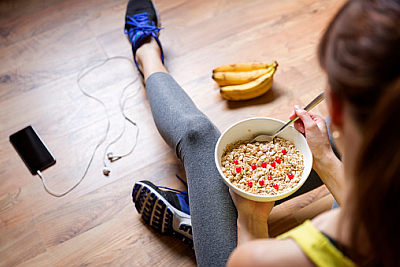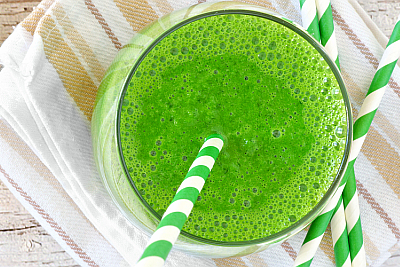We exercise for many reasons—to challenge ourselves, to relieve stress, to socialize and to keep our weight in check. But all regular exercisers have one thing in common: You want to get the most out of every workout, whether it’s a morning run, a strength training class, or a long bike ride on the weekend.
 “Performance tips aren’t just for professional or extreme athletes; they’re for anyone who wants to give it their best,” agrees Aramark Registered Dietitian (RD) Laura Johnson, who specializes in sports nutrition. “And that starts with the right fuel.”
“Performance tips aren’t just for professional or extreme athletes; they’re for anyone who wants to give it their best,” agrees Aramark Registered Dietitian (RD) Laura Johnson, who specializes in sports nutrition. “And that starts with the right fuel.”
You know to keep water handy, but did you know that different workouts call for different food combinations, best eaten at certain times? We talked with Laura to learn the what, when, and why of eating for exercise.
TIMING IS EVERYTHING
In a sense, everything you eat can affect your performance on the road and in the gym. This is especially important if you’re training for a community 5K or other competition. “Even if your sweat session is more than four hours away, you can still choose food that puts your best foot forward,” Laura shares.
The timing of your workout can really influence your pre-exercise nutrition needs. All meals should be complete with carbs, protein and healthy fats. However, make sure you are not relying on a meal you ate four or more hours ago to power you through your workout. Grab a light snack an hour or two before. A banana with nut butter or a few crackers with string cheese should do the trick.
Laura also reminds us the day of an intense workout is not the time to experiment and try something new. “After all that preparation, you don’t want to risk upsetting your stomach when it matters most,” she cautions. “Try new foods when the stakes are lower.”
YOU’VE GOT THE POWER
Laura has a specific game plan for “power exercise” that involves spurts of moderate to high-intensity movement. “If you lift weights, sprint, or play a team sport like football, this one’s for you,” she says.
 Before: Have something 90 minutes to four hours before your workout, as “eating too close to physical activity may cause stomach cramps or similar problems that could slow you down,” Laura explains. Choose food that’s low in fiber and fat. Your body will digest them faster—another good way to avoid pesky gastrointestinal issues. Meanwhile, a moderate amount of protein will help keep your blood sugar stable and have you feeling good rather than “crashing”. Her favorite picks? Cereal with 2% milk and a glass of orange juice, or an egg with toast.
Before: Have something 90 minutes to four hours before your workout, as “eating too close to physical activity may cause stomach cramps or similar problems that could slow you down,” Laura explains. Choose food that’s low in fiber and fat. Your body will digest them faster—another good way to avoid pesky gastrointestinal issues. Meanwhile, a moderate amount of protein will help keep your blood sugar stable and have you feeling good rather than “crashing”. Her favorite picks? Cereal with 2% milk and a glass of orange juice, or an egg with toast.
During: Power events typically don’t last long enough to require a pit stop. But if you need a pick-me-up, opt for something easy to digest, such as raisins or a banana.
After: If you have another workout coming up the next day, eat something within two hours after to replenish your energy stores, as the body is most efficient at absorbing nutrients after exercise. If you have multiple events in the same day, snack on fruit, a granola bar, or low-fat yogurt in between. Laura then recommends the next nutritious meal provide adequate calories from whole grains, veggies, and protein sources.
THE LONG HAUL
Running, cycling, and other intense cardio will test your endurance. That means you’ll need a different food formula for success.

Get Recipe: Peanut Butter Power Toast
Before: One to four hours leading up to your workout, consume something high in carbohydrates with a moderate amount of protein. “Again, too much protein can be a recipe for GI distress,” Laura says. “But everybody’s different, so figure out what works for you.” Our recipe for Peanut Butter Power Toast is a great choice.
During: Any activity lasting more than an hour calls for carbohydrates. This is especially true if you’ve been exercising in the heat, as you lose electrolytes through sweat. “Sports drinks are designed with the right mix of glucose and fructose—so don’t dilute them,” explains Laura. “Solid fruit or some fruit juice with a few pretzels is another great option.”
After: Time to refuel again! If you’re planning another run or a spin class within eight hours, eat a high-carb snack immediately to help your body prepare for the next round. In some situations, you may need more than one snack session to help sustain you until your next full and balanced meal. “Carbs, protein, fluids, and electrolytes are all important for recovery. Cover the major food groups and you’ll be in good shape,” Laura advises.
Note: If your workout combines high- and low-intensity moves—what Laura calls “intermittent exercise”—you may need to mix up these strategies. Experiment until you discover what works for you.
 REAL FOOD FIRST
REAL FOOD FIRST
A sports nutritionist’s advice is suitable for just about anyone looking to up their game: Eat a variety of healthy foods and eat fewer processed foods. Processed foods are stripped of important nutrients, so grab fresh food when possible.
“Chances are, this approach will give you enough energy from macronutrients—carbohydrates, protein, and fat—and plenty of micronutrients, the vitamins and minerals from fruits and vegetables that help your body in countless ways,” she explains. “If you restrict or leave out an entire food group, it could affect your overall performance.”
And what about dietary supplements? “As the name implies, they should only be used to supplement the food you’re eating,” Laura states. “They’re not meant to replace real food.”
For example, individuals who follow a vegetarian or vegan diet may lack certain nutrients found in dairy and meat. Female endurance athletes also risk not getting enough calcium, vitamin D, and iron. “That just means you need to get these nutrients from other food sources, or supplements if needed,” says Laura. “Working with an RD can help you plan and troubleshoot.”
She recommends the following healthy, workout-worthy meals:
-

Get Recipe: Tropical Green Smoothie
Smoothie made from yogurt, fruit, spinach, and chia seeds (or try our Tropical Green Smoothie recipe), paired with a slice of whole-grain avocado toast
- Two-egg omelet stuffed with veggies and a sprinkle of cheese
- Bowl of fortified cereal and milk topped with dried fruit, nuts, and seeds
- PB&J served with apple slices, baby carrots, and a glass of milk
- Whole-grain pasta with marinara sauce, meatballs, and a touch of parmesan cheese, with cooked veggies on the side
- Chicken quesadilla made from whole-grain tortilla served with beans, onions, salsa, and avocado slices for some good fat
Check out our recipe section for Breakfast Berries and Chia Seed Parfait and other inspiration to feed your potential.
Note: Since everyone’s health history and nutritional needs are so different, please make sure that you talk with your doctor and a registered dietitian to get advice about the diet and exercise plan that‘s right for you.

